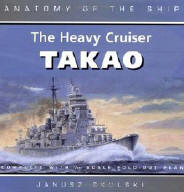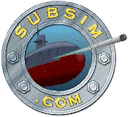|
|
||
 Anatomy
of the Ship Heavy Cruiser Takao Anatomy
of the Ship Heavy Cruiser Takao
Author: Janusz Skulski
When they entered service with the Imperial Japanese Navy in 1932, the
four ships of the Takao-class, Takao, Atago,
Maya, and Chokai, were probably the most powerful heavy
cruisers in the world. Mounting 10 8-inch guns along with 16 (later
24) of the devastating "Long Lance" torpedoes, and with a top speed of
35 knots, the Takao class were more than a match compared to
their foreign contemporaries.
Takao herself had a long, rather interesting career. Having participated in almost every major campaign of the Second World War, Takao was almost sunk by two torpedoes fired from the submarine Darter during the Battle of Leyte Gulf. Towed to Singapore, she was deemed too heavily damaged to be repaired, and spent the rest of the war as a floating anti-aircraft battery. Takao was further damaged by limpet mines laid by British commandos on July 31, 1945. After the war, the Allied occupation forces used Takao as a communication, repair, and accommodation base, eventually scuttling the ship in the Malacca Straight on October 27, 1946. Originally published in 1994 and republished in 2004, The Heavy Cruiser Takao is divided into three main sections and follows the same format as the other books in the Anatomy of the Ship series. The 2004 reprint has a plan and profile of the ship as built on the inside of the cover. The first section is a 17 page text introduction covering a large number of topics related to Takao's life and design, including a full chronology of the ship's history. No less than 28 tables are included in this section, showing the specifications of the floatplanes, guns, and torpedoes, weight distribution statistics, hull characteristics, stability data, and information on searchlights and radars, machinery, armor layout, fire control installations, and hull design. The second section features 48 photographs of the ship fitting out, undergoing refits and trials, and "in action." Many of these photographs are murky and show their age, but since they're so rare I really can't complain. The Takao was unique among WWII-ea Japanese warships in that it survive the war, had a long, well-documented history, and was extensively studied after the war by members of the American Naval Technical Mission to Japan. Takao and her sisters weren't built in complete secrecy, and the postwar destruction of plans and drawings apparently weren't a priority. That's not to say this book contains a full internal analysis of the ship's interior. If you're expecting detailed views of the steam pipe arrangements, or of, say the hull structure at Frame 216, you might be disappointed. However, detailed plans of each deck, and multiple sections of the hull, make up somewhat for this unfortunate deficiency. The plans section occupies 210 pages, more than 4/5th of the book.
Since Takao underwent a number of refits during her 12 year
career, most notably a major reconstruction 1944, this volume is
larger than most of the series. Skulski is careful to note the ship's
changing configuration in his external plans, focusing on the ship as
commissioned, in August 1937, after her 1939 reconstruction, and her
final configuration at the Battle of Leyte Gulf. Section J shows the aircraft deck rails and turntables, catapults, and three view-drawings of the six types of floatplanes carried onboard between 1932 and 1945. Section K, on boats, is similarly arranged, with detailed plans of the 11 meter motor boats, 12 meter motor launch, 9 meter cutter, and 6-meter and 8-meter sampans. The final page shows the proper dimensions of Takao's four main flags. I've always been on the lookout (bad pun) for a good set of ship plans that won't break my bank account. I'm a sucker for detail, and lots of it. Some of the other books in this series, especially John Robert's book on the Battleship Dreadnought and John McKay's on the Flower-class Corvette, are impressive works in their own right. But Janusz Skulski's work is perhaps the finest naval drafting I've ever had the pleasure of laying eyes on, and his fastidiousness for detail is oftentimes absolutely mindblowing. Almost no rivet goes unnoticed, and his usage of shadow and shading makes what could have been boring drawings come alive. The only thing really missing is decent set of drawings showing the ship's structure, hull plating, and machinery. The General Arrangement plans are nice by themselves, but don't say a whole lot about how the ship was put together. Sure, I now know where the Soy Sauce was kept (the lower deck, between Frames 11 and 16), but it would be nice to know how they dealt with the structural weakness around the forward main turrets, or why fuel capacity was sacrificed for increased speed. The Heavy Cruiser Takao is a superb entry in the "Anatomy of the Ship" series, and it would have been even better if it had more information on internal arrangements. Like most of the series, it's getting harder and harder to find a copy (the cheapest "new" copy on Amazon currently goes for $45), and increasingly sought after. With the recent release of Aoshima's 1:350 model kit of the Takao, this is a reference that no serious modeler should go without.
|









